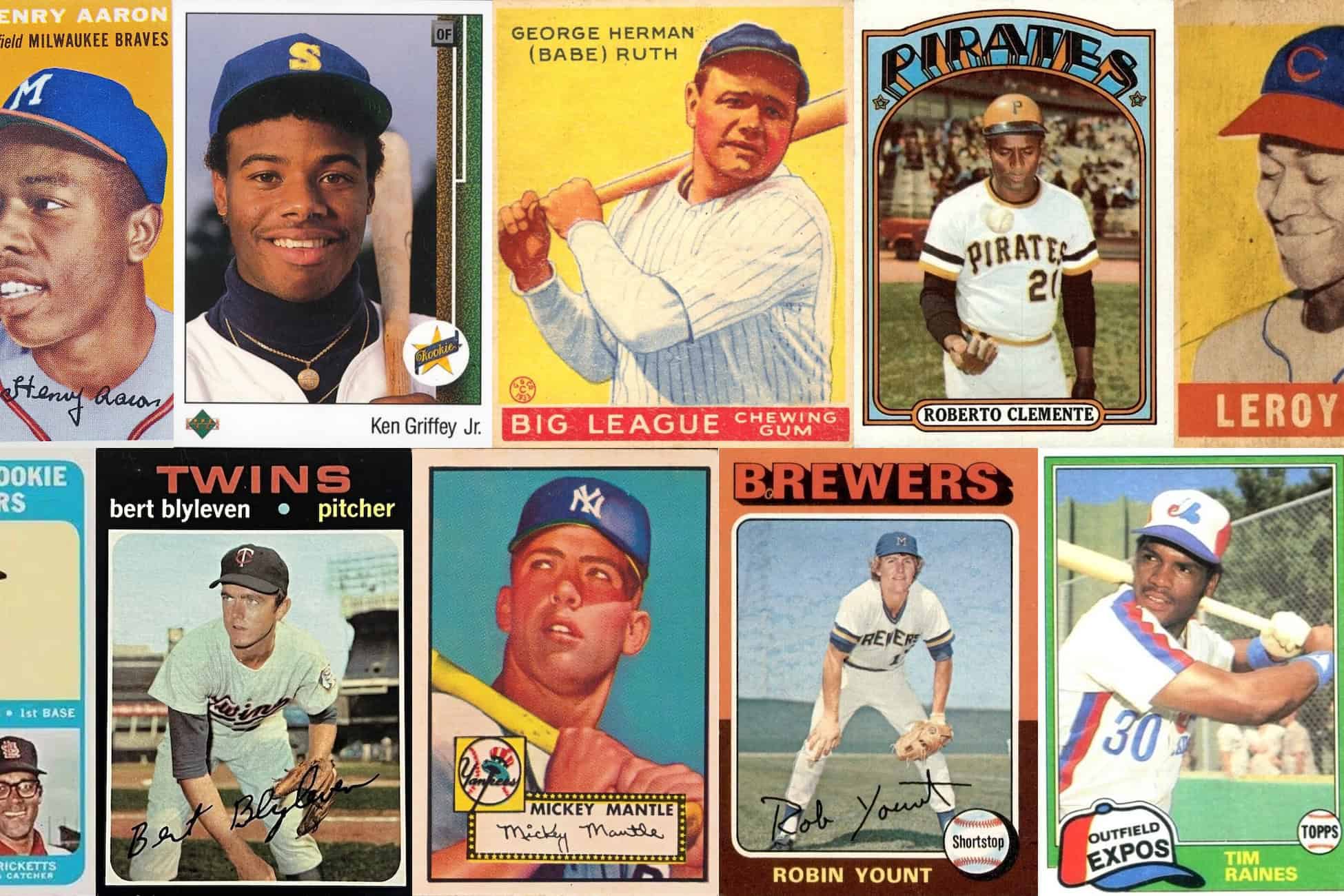For generations, baseball cards have been more than just pieces of cardboard featuring our national pastime’s heroes. They are tangible snapshots of history, connecting fans to their favorite players and teams. Beyond baseball itself, the visual artistry of baseball card designs has played a crucial role in their enduring appeal. The aesthetic choices of baseball card designs, from the layout and typography to the photography and color palettes, can shape the direction of the entire hobby.
This article delves into the captivating world of baseball card designs, exploring the top 10 most iconic examples throughout history. We’ll examine what makes these particular designs so memorable, by analyzing the elements that have allowed them to stand the test of time. From the early, simplistic elegance of tobacco cards to the bold and innovative styles of more recent decades, each design tells a story.
1975 Topps
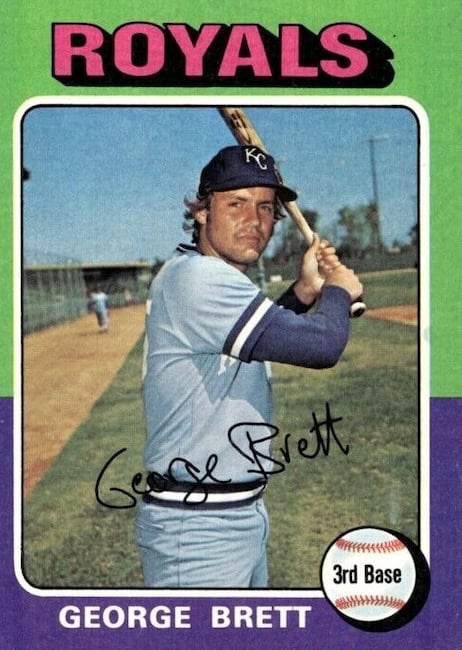
Summary
Dual-color borders and a retro font make it one of the most visually vibrant sets. Also one of the few vintage sets released in mini form.
Key Cards
George Brett (RC), Robin Yount (RC)
About the Design
The 1975 Topps baseball card set is a vibrant and memorable issue, instantly recognizable for its bold, colorful borders. Each card features a two-tone frame around the player’s photo. It utilizes a wide array of color combinations that epitomize the baseball card designs and trends of the mid-1970s. This departure from the single-color borders of previous years made the set visually striking and helped it stand out. The player’s facsimile autograph is prominently displayed on the card front. This adds a personal touch. Card backs are printed in red and green ink on a gray card stock, with bios, statistics, and a cartoon.
Cultural Significance
Beyond its eye-catching design, the 1975 Topps set holds significant importance for collectors due to its impressive roster of rookies. This set boasts the first mainstream cards of Hall of Famers George Brett, Robin Yount, Gary Carter, and Jim Rice. Additionally, the set includes cards of numerous legendary players such as Hank Aaron, Nolan Ryan, Mike Schmidt, and Reggie Jackson. The complete set comprises 660 cards, released in a single series. It also features subsets highlighting the previous season’s milestones, league leaders, and MVP award winners, adding depth to the set.
For dedicated baseball card collectors, the 1975 Topps set presents both opportunities and challenges. The colorful borders, while aesthetically pleasing and a new take on baseball card designs, are notoriously prone to chipping. This makes high-grade examples particularly difficult to find and thus more valuable. Variations within the set, such as team checklists with different colored backs, also add to the collecting intrigue. Furthermore, the set includes a notable error card, the Steve Busby card, which actually pictures catcher Fran Healy. This adds a quirky element for error collectors. (Spoiler alert: They don’t even look alike.)
The combination of iconic rookie cards, superstar veterans, distinctive design, and condition sensitivity makes the 1975 Topps set a cornerstone of many vintage baseball card collections.
1955 Topps
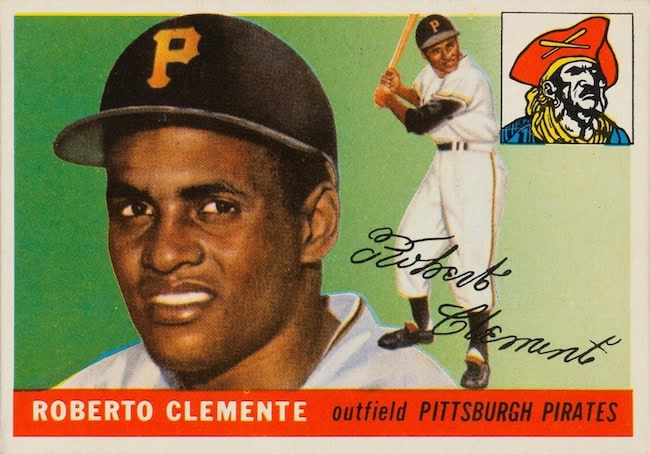
Summary
Combines action shots with portrait images in a horizontal layout. The set feels cinematic, showcasing motion and personality.
Key Cards
Jackie Robinson, Roberto Clemente (RC), Sandy Koufax (RC), Harmon Killebrew (RC)
About the Design
The 1955 Topps set is indeed famous for its pioneering horizontal baseball card designs. It’s a distinct departure from previous Topps issues, and a format that offered a wider canvas for the card design. This horizontal orientation allowed for more dynamic action shots and different framing possibilities. The player’s name and team often appeared along the bottom edge, complementing the broader image.
Cultural Significance
The adoption of this wider format in 1955 was a bold move by Topps. It contributed significantly to the set’s lasting appeal and historical importance in the hobby. It showcased the players in a new and engaging way, helping to solidify Topps’ position in the baseball card market. The significance of the 1955 Topps set is amplified by the inclusion of numerous legendary players and important rookie cards. Notably, it features the highly coveted rookie card of Hall of Famer Roberto Clemente. Other iconic players in the set include Jackie Robinson, Willie Mays, Mickey Mantle, and Ted Williams.
For collectors, the 1955 Topps set offers a rewarding, albeit often challenging, pursuit. The 1955 Topps cards are 2 5/8″ by 3 3/4″. The larger size makes them more susceptible to wear and tear over time. Corner rounding and creasing are common issues. High-grade examples of key rookie and star cards command significant premiums in the market.
The combination of its pivotal design, the presence of iconic players’ early cards, and the inherent condition challenges solidifies the 1955 Topps set as an essential piece of baseball card history.
1955 Topps vs. 1956 Topps
At first glance, the 1955 and 1956 Topps sets look similar, and each is iconic in its own right. However, despite the similar design, the 1955 issue often wins the day. The most significant factor is the presence of the true rookie card of the legendary Roberto Clemente. This single card carries immense historical weight and value. Meanwhile, the 1956 set features the return of Mickey Mantle to Topps after being exclusive to Bowman in 1954-1955. It also includes his Triple Crown season, but the allure of Clemente’s rookie often outweighs this for many vintage collectors.
Furthermore, the 1955 set has a smaller checklist (206 cards vs. 340 cards). It is a more manageable and focused collecting pursuit. The design of the 1955 set also has a simpler background behind the player photos. This is cleaner and more aesthetically pleasing, allowing the player image to take center stage without distraction. The 1956 set introduced team cards and checklists for the first time in a Topps set. This is trendsetting for a portion of the collecting community. Nonetheless, the historical importance of Clemente’s rookie gives the 1955 Topps set a slight edge.
1948 Leaf
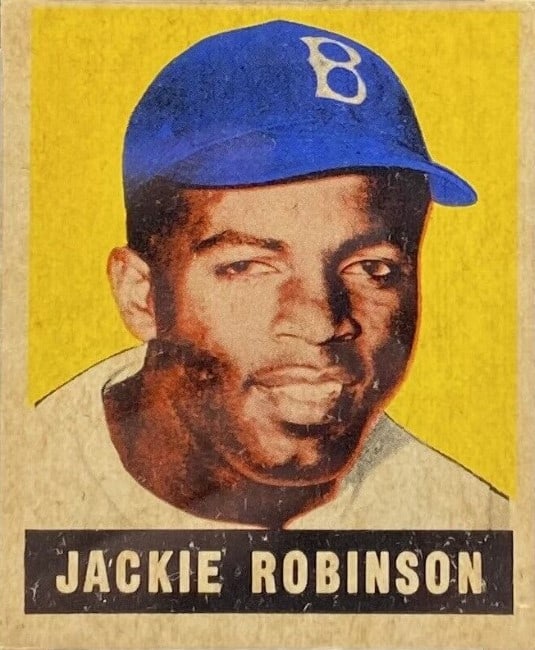
Summary
Blends painterly portraits with dynamic in-game moments across a vibrant, slightly abstract canvas. Evokes a sense of post-war energy and character.
Key Cards
Jackie Robinson (RC), Satchel Paige (RC), Babe Ruth, Joe DiMaggio
About the Design
The 1948 Leaf baseball card set, while small in size, holds a unique and significant place in the history of baseball card designs. This early post-war issue is notable for its vibrant, albeit somewhat crude, color artwork. Each card features a painted rendition of the player, often with exaggerated features and set against a simple, colorful background. The player’s name is printed in a bold font. This artistic approach was a departure from the photographic cards that would soon dominate the hobby. Therefore, it lends the 1948 Leaf set a distinctive, almost folk-art quality. Many collectors find it charming and historically significant as one of the first color baseball card sets.
Cultural Significance
Many mysteries lurk beneath the surface of the 1948 Leaf set, including the exact number of cards produced. (The set was never fully released as intended, with high numbers being very scarce.) The 1948 Leaf set boasts the rookie cards of several baseball legends, most notably Jackie Robinson and Satchel Paige. In particular, the Paige card is highly prized. At the age of 42, Paige’s rookie card commemorates a pivotal figure transitioning from the Negro Leagues into MLB. The set also includes iconic players like Babe Ruth (a very tough short print), Larry Doby and Ted Williams. The scarcity of the high-numbered cards, rumored to have been destroyed due to production issues, adds another layer of intrigue and challenge.
For collectors, the 1948 Leaf set presents a fascinating glimpse into the early landscape of baseball card designs. The painted artwork, while not always technically precise, offers a unique artistic interpretation of the players of the era. The rarity of the high-number series makes completing the set a significant accomplishment. Moreover, the inclusion of key rookie cards, especially Paige’s, elevates its importance and value within the hobby. The 1948 Leaf set stands as a testament to a transitional period in baseball card designs. It bridges the gap between earlier, often simpler designs and the more photographically driven sets that would soon follow.
1951 Bowman
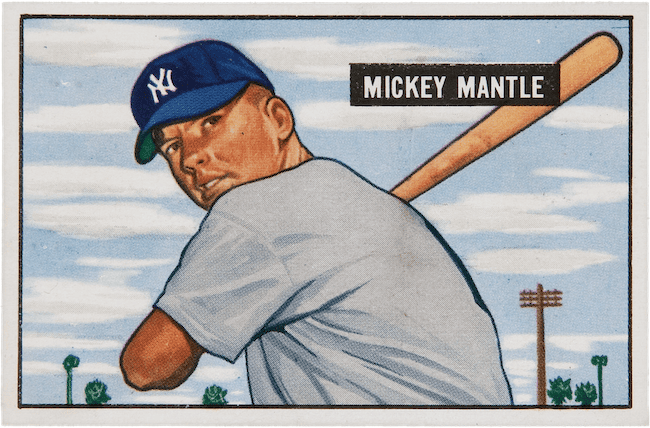
Summary
Presents crisp, colorized photographs with a clean, straightforward design, often featuring close-up player portraits.
Key Cards
Mickey Mantle (RC), Willie Mays (RC), Whitey Ford (RC)
About the Design
The 1951 Bowman set represents a fascinating crossroads in baseball card history. It marks Bowman’s bold foray into full-color photography and its contribution to modern baseball card designs. Gone were the often charming, yet sometimes artistically inconsistent, hand-drawn illustrations of previous Bowman sets. Instead, collectors were greeted with vibrant, eye-catching images of their heroes. It was a significant departure from the monochromatic offerings at the time. This pioneering use of color immediately set the 1951 Bowman set apart and influenced the future of the hobby.
Beyond the groundbreaking use of color, the design of the cards themselves holds a certain nostalgic appeal. The straightforward, uncluttered layout featured a prominent player image set against a simple colored background. The card clearly displays the player’s name and position in a clean, sans-serif font. This unpretentious design allowed the vibrant photography to truly shine. While not as elaborate as some later sets, the 1951 Bowman cards connect to the era they represent.
Cultural Significance
The importance of the 1951 Bowman set extends beyond its aesthetic innovations. It captures a pivotal moment in baseball history. Featuring iconic players like Mickey Mantle and Willie Mays in their true rookie cards, along with legends such as Ted Williams and Yogi Berra, the set is impactful. The 1951 Bowman set also includes short-printed high-number cards, adding a layer of challenge and desirability for serious collectors.
The combination of its historical significance, groundbreaking design, and the presence of key rookie cards solidifies the 1951 Bowman set as a cornerstone of any significant vintage baseball card collection.
1971 Topps
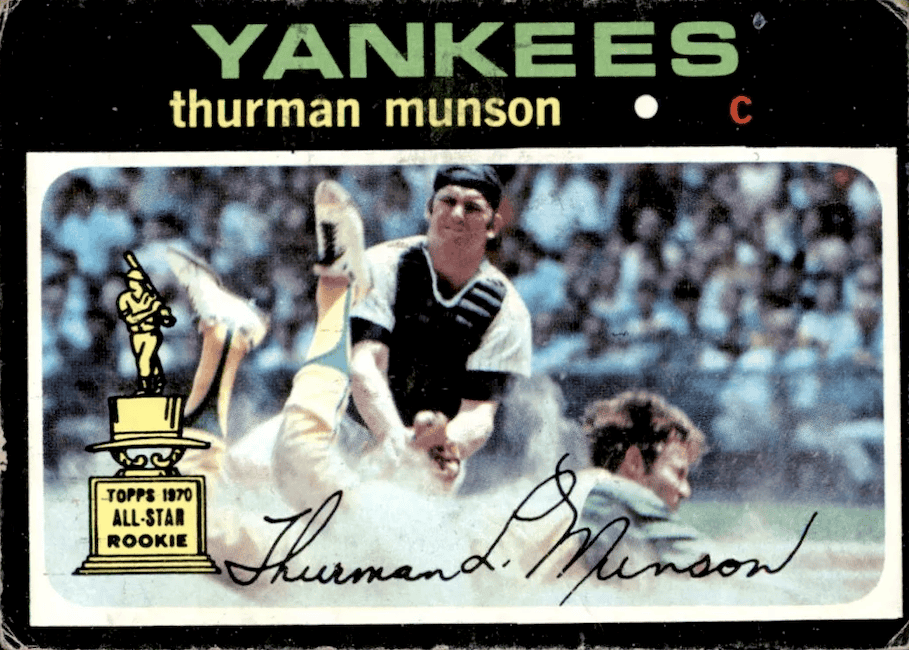
Summary
The bold black borders stand out – and chip easily, adding a unique challenge for collectors. It was also one of the most distinctive and modern-looking sets of the early 1970s.
Key Cards
Thurman Munson, Bert Blyleven (RC), Nolan Ryan, Roberto Clemente
About the Design
The 1971 Topps set stands as a visually striking and expansive issue. Boasting a robust 752 cards, it has a design that is instantly recognizable. Characterized by its black borders and vibrant player photography, the set possesses a bold aesthetic that distinguishes it from its predecessors. Within those black borders, collectors find a treasure trove of baseball talent. The set includes the rookie cards of Hall of Famers Steve Garvey and Dusty Baker, alongside established stars like Hank Aaron, Willie Mays, and Roberto Clemente.
Cultural Significance
However, those distinctive black borders, while visually appealing, present a significant challenge for condition-sensitive collectors. They are notoriously susceptible to chipping and wear, making high-grade examples of even common cards relatively scarce and valuable. This inherent difficulty in obtaining pristine cards adds another layer of intrigue for those pursuing the set. Furthermore, the 1971 Topps set is notable for its inclusion of variations and errors. These have become highly sought after by dedicated hobbyists, adding depth and complexity to the collecting experience.
Beyond the design and condition challenges, the 1971 Topps set holds a special place in the hearts of many collectors. It evokes a sense of nostalgia for a specific time in baseball history. The set captures the look and feel of the early 1970s game. The combination of its iconic design and the inherent challenges in assembling a high-grade set contribute to the enduring popularity and importance of the 1971 Topps baseball card set within the hobby.
1954 Topps

Summary
Features a unique design with a headshot and a smaller action shot of the player, without a top border
Key Cards
Ernie Banks (RC), Hank Aaron (RC)
About the Design
The 1954 Topps baseball card set is one of the most iconic and beloved releases of the post-war era, known for its bold card design and rich rookie class. Each card features a horizontal layout with a vivid color background, a large portrait of the player, and a smaller full-body action shot. The card includes each player’s facsimile signature, and team logos add to the eye-catching appeal. Unlike many sets of the time, the 1954 Topps cards did not include stats on the back – instead, the reverse side offers a player bio, cartoon, and career highlights, all presented in a clean, engaging format that emphasized personality as much as performance.
Cultural Significance
One of the reasons the 1954 set holds such weight in the hobby is its unmatched rookie lineup. The rookie cards of Hank Aaron, Ernie Banks and Al Kaline make this set a cornerstone for collectors chasing Hall of Fame talent. Topps also featured Ted Williams on both the first (#1) and last (#250) cards of the set – an unusual move that bookends the series with one of the game’s greatest hitters. Additionally, Topps and Bowman were direct competitors for the first time in 1954. It sparked a golden era of innovation and rivalry in the card industry. With its blend of timeless design and legendary player debuts, the 1954 Topps set remains a favorite among vintage collectors.
1989 Upper Deck
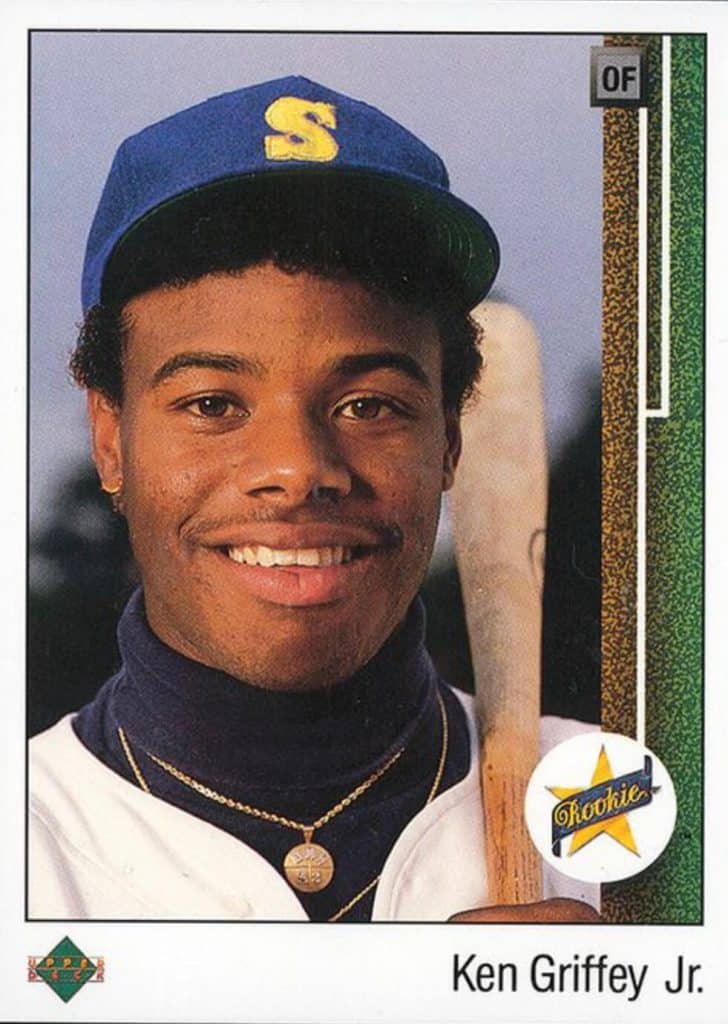
Summary
This set introduced high-quality printing, glossy finishes, and holographic security features, setting a new standard for card production.
Key Cards
Ken Griffey Jr. (RC), Randy Johnson (RC), Dale Murphy (error), Gary Sheffield (RC)
About the Design
The 1989 Upper Deck baseball card set is widely regarded as a turning point in the hobby. It ushered in the modern era of premium card production. It was Upper Deck’s debut release, and it made an immediate impact with its sleek design, high-quality materials, and revolutionary security features. Each card was printed on white, glossy stock with full-color, high-resolution photography – offering a dramatic upgrade over the darker, cardboard-based cards from competitors. The front of each card showcased a crisp action photo, the player’s name, team, and logo, while the back featured a second photo, complete career statistics, and a hologram logo to prevent counterfeiting – an industry first.
Cultural Significance
The most famous card from the set, and arguably one of the most iconic cards ever made, is #1: the Ken Griffey Jr. rookie card. Griffey hadn’t played a Major League game when the set was released, so he was a calculated choice to lead the checklist. He instantly became the face of a new generation of collectors. The card’s clean layout, centered photo of a young and smiling Griffey in a Mariners cap, and the future Hall of Famer’s career trajectory made it the defining card of the junk wax era.
Beyond Griffey, the 1989 Upper Deck set is valued for its symbolism as much as its contents. It challenged industry norms by offering a product at a higher price point with significantly better print quality and security. It forced competitors like Topps, Donruss, and Fleer to rethink their baseball card designs and manufacturing standards, helping raise the bar across the board. With a 700-card base set and a clean, consistent layout, Upper Deck’s inaugural release helped redefine what collectors expected from a baseball card, making 1989 a watershed moment in modern hobby history.
1933 Goudey

Summary
The first major bubblegum card set. Features colorful artwork, thick stock, and a cartoonish charm.
Key Cards
Babe Ruth (four versions), Napoleon Lajoie, Lou Gehrig (two versions), Benny Bengough
About the Design
The 1933 Goudey baseball card set, officially titled “Big League Chewing Gum,” is one of the most important releases in the history of the hobby. Produced by the Goudey Gum Company of Boston, it was the first widely distributed gum-and-card product of the modern era and marked the beginning of the bubble gum card boom. The cards measure approximately 2 3/8″ by 2 7/8″, slightly larger than the standard cards that would follow, and each one features a colorful, hand-drawn portrait or action image of the player set against a bold, solid background. The artwork was vibrant and eye-catching, with a clean layout and the player’s name and team printed across the bottom.
Cultural Significance
What truly sets the 1933 Goudey set apart is its legendary roster of players and its historical context. This 240-card set includes four cards of Babe Ruth (#53, #144, #149, and #181), two of which are considered iconic in the hobby. It also features a coveted card of Lou Gehrig (#92 and #160), as well as appearances by Hall of Famers like Jimmie Foxx, Rogers Hornsby, and Lefty Grove. One of the most famous stories surrounding the set is the mysterious absence of card #106 – Nap Lajoie – which wasn’t issued with the original series and only became available in 1934 by mail request, making it one of the most sought-after rarities in the hobby.
The 1933 Goudey set holds tremendous historical importance as the first major baseball card release during the Great Depression. At a time when baseball offered an escape from economic hardship, these cards gave children a colorful and affordable way to engage with the game. Goudey’s innovation of including gum with the cards and offering high-quality printing elevated the product and inspired other companies to enter the market. To this day, the set is revered not only for its visual appeal and superstar checklist but also for its role in launching the golden age of baseball cards.
1909-1911 T206
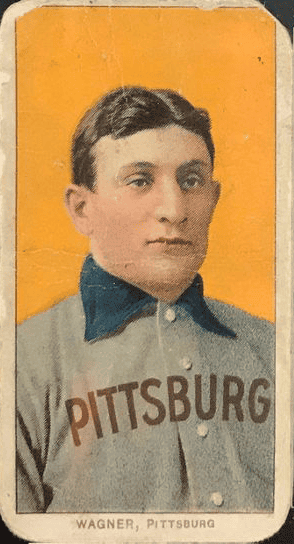
Summary
Known for its timeless lithograph portraits, white borders, and back brand variations. The design has influenced countless retro sets.
Key Cards
Honus Wagner, Eddie Plank, Ty Cobb
About the Design
The T206 baseball card set, issued between 1909 and 1911 by the American Tobacco Company, is arguably the most famous and revered set in the history of the hobby. Often referred to as “The White Border Set,” T206 cards are known for their elegant design, which includes a lithographic color portrait or action shot framed by a white border, with the player’s name and team at the bottom. Measuring approximately 1 1/2″ by 2 5/8″, the cards were small and designed to fit into cigarette packs as promotional inserts. The reverse side featured advertisements for one of 16 different tobacco brands, which has since become a subcategory of collecting in its own right.
Cultural Significance
The set includes over 500 cards, with subjects ranging from stars of the Deadball Era to lesser-known regional players, offering a sweeping snapshot of early 20th-century baseball. It features multiple cards for some players, with different poses or team affiliations, including three different Ty Cobb cards and four cards of Hall of Famer Christy Mathewson.
The Honus Wagner card from the T206 set is the crown jewel of baseball card collecting and perhaps the most famous sports card in existence. Printed sometime between 1909 and 1911, it’s believed that fewer than 70 authentic copies survive today, making it exceedingly rare. The exact reason for its scarcity has become part of hobby lore – some believe Wagner objected to his likeness being used to promote tobacco to children, while others suggest it may have been a contractual or financial dispute with the American Tobacco Company.
Whatever the reason, the result was that his card was pulled from production early, creating a legendary scarcity that has fascinated collectors for over a century. With its dignified portrait of Wagner in his Pittsburgh uniform and clean, classic layout, the card has a timeless visual appeal. It has repeatedly set records at auction, with high-grade copies selling for over $6 million, and remains a symbol of the collecting world’s history, prestige, and passion. The mystique of the T206 Wagner extends beyond the card itself – owning one represents a tangible connection to both the origins of baseball and the earliest days of card collecting.
Collectors prize the T206 set not only for its age and rarity but also for the artistry and historical depth it represents. The vivid lithographic printing gives the cards a distinct look that remains unmatched, and the range of player representation – from legends to obscure journeymen – makes it a cornerstone for vintage enthusiasts. Whether pursued as a full set, by team, or by back variations, T206 remains the gold standard of pre-war baseball card collecting and a true icon of the hobby.
1952 Topps
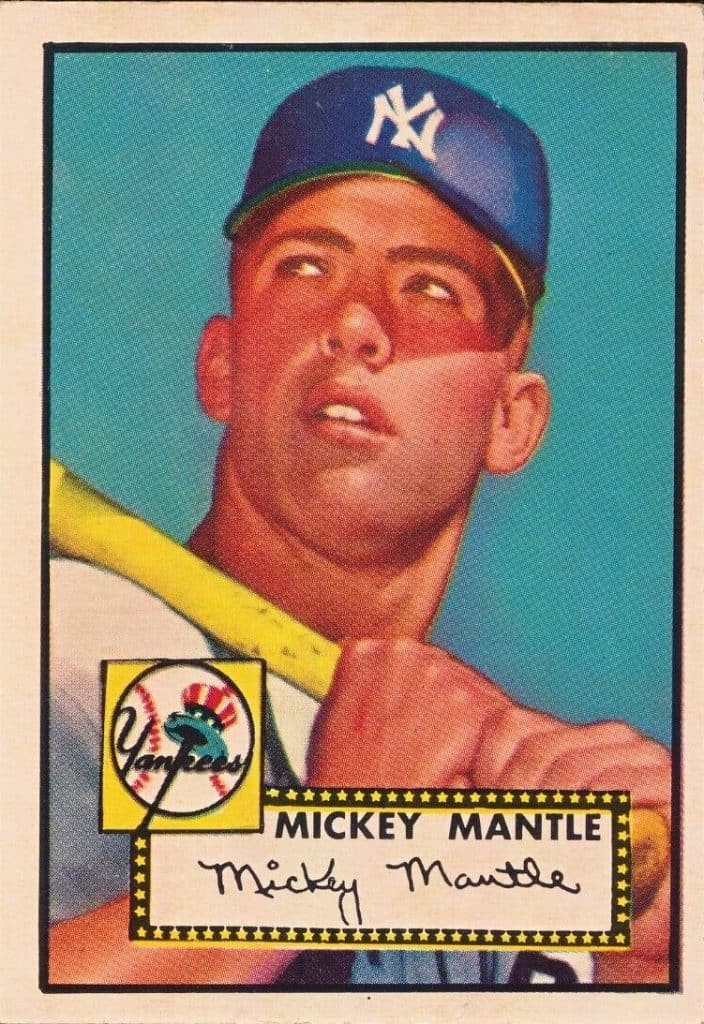
Summary
This is the blueprint for the modern baseball card – large size, bold team name, facsimile autograph, and color portrait. The 1952 set also introduced card numbers and a more standardized layout.
Key Cards
Mickey Mantle, Eddie Mathews (RC)
About the Design
The 1952 Topps baseball card set is often hailed as the most iconic post-war set ever produced and a landmark moment in the evolution of the hobby. Designed with kids and collectors in mind, the cards were a dramatic leap forward in terms of size, style, and visual impact. Measuring a larger 2 5/8″ by 3 3/4″, each card featured a full-color portrait based on actual photographs, along with the player’s name, team, and position displayed in a banner at the bottom. The reverse side included a short biography, complete career stats (a relatively new feature at the time), and a bold red and black color scheme that gave the set a polished, professional look. The set contained 407 cards and was released in six series throughout the year – though the final series would become one of the most infamous in hobby history.
Cultural Significance
The most famous card in the set – and arguably the most celebrated card of the modern era – is Mickey Mantle’s first Topps card (#311). While not his actual rookie (Mantle appeared in the 1951 Bowman set), the 1952 Topps card is considered his most iconic due to its eye-catching design and placement in Topps’ first flagship release. High-grade examples of the card have fetched millions of dollars at auction, cementing its place as a true blue-chip collectible. Other key players in the set include Jackie Robinson, Willie Mays, and Eddie Mathews, whose card (#407) anchors the rare high-number series. That final sixth series, printed late in the baseball season, saw limited distribution and many unsold cases were allegedly dumped into the Hudson River, contributing to the scarcity – and allure – of the high-number cards.
The 1952 Topps set marked the company’s first serious push into the baseball card market and set the template for what modern card designs would become. Under the direction of Sy Berger, who famously designed much of the set on his kitchen table, Topps created a product that blended visual appeal with deeper player information, signaling a shift from ephemeral gum inserts to collectibles with lasting value. Its combination of star power, pioneering design, and nostalgic charm has made it a perennial favorite among vintage collectors and a touchstone in the story of baseball cards.
